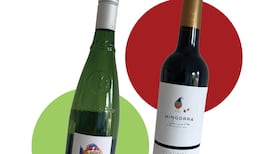There is a clichéd view of the female wine drinker as only being interested in white wines, preferably Sauvignon Blanc or Pinot Grigio. The male equivalent is a bottle of rich powerful red, preferably accompanied by a large rare steak or hamburger.
Such generalisations are dangerous, as the world of wine drinking is far more complex. But as is often the case, they do contain a smidgen of truth. Sales of Sauvignon and Pinot Grigio have been buoyant for years now, largely driven by female wine drinkers enjoying a glass of wine together. There is also a group of males who think all wine must be red and that bigger is always better.
Often the first and perhaps only thing they look at on a label is the level of alcohol contained within. Traditionally, the Irish male looked to the Rhône valley for sustenance, Châteauneuf- du-Pape if he could afford it.
This heart-warming French classic was subsequently joined, first by Australian Shiraz, Ripassa and Amarone from the north of Italy, and more recently by Malbec from Argentina. In a way that makes other countries quite jealous, Malbec has become the signature wine of Argentina, popular the world over, especially with men.
Ally Alpine of Wines on the Green observes that most of those who buy Malbec are indeed 25- to 40-year-old males. They are also less sensitive to price, being quite happy to pay in excess of €20 for a weekend treat, alongside the mid-week €10 bottle.
The success of Malbec on the world stage has been a recent phenomenon. Twenty years ago, the Argentinians were busy ripping up many of their oldest vines, replacing them with the higher-yielding but vastly inferior Criolla Grande grape variety.
Then a drop in home consumption meant producers had to look abroad for sales. It took investment, both local and from abroad, to change the focus from quantity to quality. It was only then that producers realised that they had a unique, high-quality grape variety that could become their flagship.
Conveniently, it went perfectly with that other well-known Argentinian export, beef. In the US and elsewhere, steak and Malbec became the perfect pairing, helped by the rise in popularity of gourmet “dirty” food. And yes, a medium- to full-bodied Malbec does go perfectly with grilled beef, while also standing up nicely to a chimichurri sauce.
The idea that all Malbec is big and powerful is not completely accurate. Many of those made with grapes grown on the warmer vineyards around the city of Mendoza certainly pack a real punch. But in recent years, many producers have moved to higher and higher altitudes (Argentina has some of the highest vineyards in the world) in the search for wines with greater elegance.
This is relative however. Argentine Malbec is never light. It is generally deeply coloured and perfumed. It can be spicy with lively, at times, juicy dark fruits. Think plums, blackcurrants and loganberries. Most versions are not too tannic making them ideal for immediate drinking and offering very broad appeal. The more serious versions, and Argentina is trying very hard to make some top-quality Malbec, are more structured and tannic, and built for long ageing. However even these wines are far more approachable in their youth than a top Cabernet Sauvignon.
The Malbec grape variety originated in south-west France, where it was once an important part of the blend that made up Bordeaux, as well as being the prime constituent in the deeply-coloured wines of Cahors.
Traditionally Cahors was a bit dry and tannic with light rustic fruits. More modern versions range from light supple and fruity to structured and serious. Both styles can be very good and the standard of winemaking is now generally very high and prices reasonable.
Cahors must be made from a minimum of 70 per cent Malbec, or Cot or Auxerrois as it is known locally. Grapes grown on the best sites by the river Lot or on the terraces above, produce the best wines.
French Malbec is hardly recognisable as the same grape grown in Argentina. Thus far, no other country has managed to produce anything similar, although Chile, the US and Australia are all trying hard. But for the moment, as New Zealand remains our primary source of Sauvignon Blanc and Italy the place we buy our Pinot Grigio, Argentina is the primary supplier of Malbec.












